
Types of Marks
Character Mark
A standard character word mark protects the literal elements of the mark without claim to any specific colors, fonts, style or design. The applicant is seeking to protect the literal elements and is free to use the mark in any design (consistent with others’ rights), without claiming an exclusive right to a particular design element.
Example:

A standard character claim will appear in the “Mark Description” once filed and will indicate the “Mark Literal Elements” (INTEL), the “Standard Character Claim”[1]Yes, the mark consists of standard characters without claim to any particular font style, size, or color and the “Mark Drawing Type” (4 – STANDARD CHARACTER MARK ) as seen below:

When applying for a standard character mark, the applicant must provide the literal elements of the mark and the USPTO will include the statement that there is a Standard Character Claim as seen above. If all the characters in the mark are in the standard character set, the USPTO will create a digitized image that meets the requirements of 37 C.F.R. §2.53(c), and automatically generate the standard character statement. The application record will indicate that standard characters have been claimed and that the USPTO has created the image. Note, that regardless of the capitalization or case of the mark as entered, the standard character mark is for protection without claim to any particular font, style, size and/or color:

A standard character drawing may be submitted only if:
- All letters and words in the mark are depicted in Latin characters;
- All numerals in the mark are depicted in Roman or Arabic numerals;
- The mark includes only common punctuation or diacritical marks; and The mark does not include a design element.[2]See, e.g., 37 C. F. R. §2.52(a).
Special Form Mark
Also known as a logo or design mark, a special form mark protects the design characteristics, including claim to a particular font, style, size, shading, and even color. Although color does not have to be claimed (in which case a black and white drawing must be provided along with a statement that the applicant is not claiming exclusive right to particular colors), a reference must be made as to the mark description, and if color is being claimed, what colors are being claimed as part of the application.
See examples of some well-known drawings below and accompanying statements of the literal elements, a description of the mark, colors claimed, if any, and design search codes (which are assigned after filing):




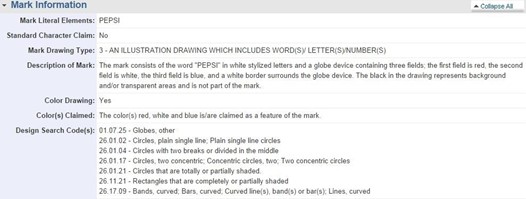

When submitting a special form mark as seen below, a properly sized JPG image file must be uploaded, which can be no smaller than 250 pixels or larger than 944 pixels in any direction. If the image includes words, letters or numerals, the literal elements must also be provided, along with the colors claimed (if any) and a complete and accurate description of the mark which incorporates all literal elements, design elements and colors if applicable:
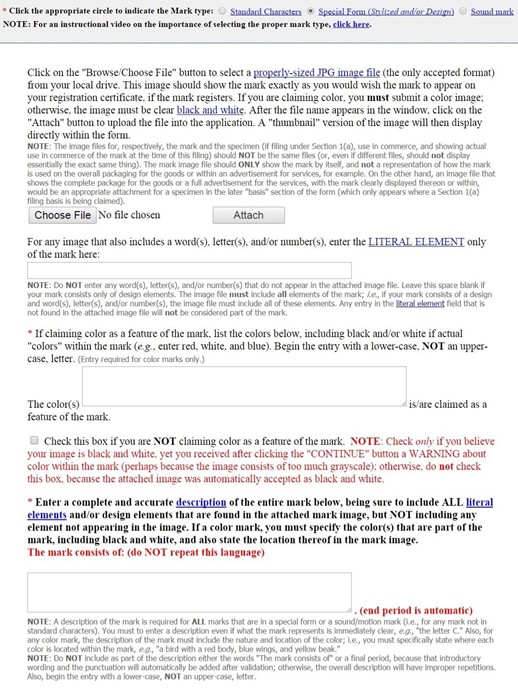
Sound Mark
A sound mark identifies and distinguishes the applicant’s products and services through audio rather than visually. An example of this is the well-known Intel chime:

For sound marks, a .WAV, .WMV, .WMA, .MP3, .MPG, or .AVI file must be uploaded, and if the mark includes words, letters or numbers, the literal elements must also be provided:
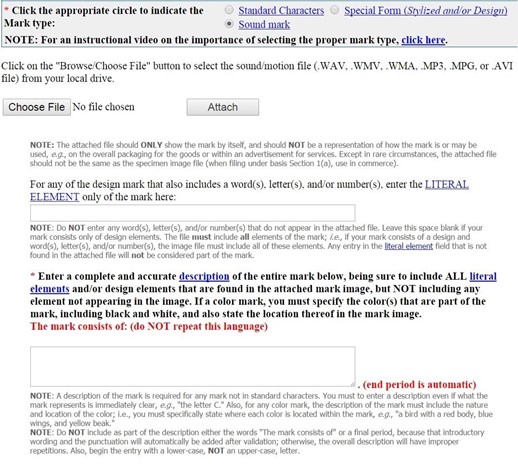
Generic Terms
Generic terms, words, and descriptors are not eligible for trademark protection. Generic terms are common words or terms that identify products and services and are not specific to any particular source. (For example, “toilet paper” for toilet paper products or “gas station” for gasoline pumping stations.) A trademark is not subject to registration if it is generic for the goods or services as identified in the trademark application. Even if a valid trademark existing for several years becomes generic (often as a result of improper use) an owner’s rights to the mark may be lost, with no remaining trademark protection and may no longer be enforceable against third parties.
In examining a potential mark’s suitability for registration, marks can be divided into five discrete categories. These categories range from fanciful (invented terms) which are typically the strongest of trademarks, to generic terms and words, which are not protectable. The stronger the mark, the more protection it will be given as against other marks.
Classification of Marks
Fanciful Marks
Fanciful marks are typically created or made up words that have no relationship at all to the goods as being described. Two examples of words invented for the sole purpose of establishing fanciful and strong trademarks are Exxon (EXXON) and Xerox (XEROX). Both of these words were invented by the trademark owners for the sole purpose of creating a fanciful and strong, protectable trademark. Despite the fact that XEROX was a fanciful word when first put into use, XEROX almost lost its trademark protection based on use of the word XEROX by consumers as a substitute term for the term “copy”. XEROX engaged in a lengthy and expensive advertising campaign requesting that people stop using the term XEROX for copy.
Arbitrary Marks
Arbitrary marks are existing words that contribute no meaning to the goods being described. For example, Chevrolet® for automobiles, Apple® for computers, and Piper® for aircraft.
Suggestive Marks
Suggestive marks are words that suggest a possible meaning or relationship to the goods or services offered under the trademark but that do not describe the goods themselves. For example, Coppertone® for suntan lotion.
Descriptive Marks
Descriptive marks are marks that describe either the goods or characteristic of the goods or the services. Often it is very difficult to enforce trademark rights for descriptive marks unless the mark has acquired distinctiveness or secondary meaning. For example, Windows® for computer software or shoeland for a shoe store. Marks that are merely descriptive are not subject to trademark registration on the principal register, but may qualify for registration on the supplemental registration, subject to certain requirements (such as the mark not being generic or deceptive). A mark is considered merely descriptive if it describes an ingredient, quality, characteristic, function, feature, purpose or use of the specified goods or services. The determination of whether a mark is merely descriptive must be made in relation to the goods or services for which the registration is sought, not in the abstract.[3]See TMEP §1209.01(b)
Generic Terms
Generic terms are words that are accepted and recognized as descriptions of a class of goods or services. For example, computer software for software, facial tissue for facial tissue. There are many examples in the history of trademarks of arbitrary marks and distinctive marks becoming generic over time for the product or service they described. Popular and common examples are aspirin, cellophane, margarine, escalator, and elevator. All of which were formerly registered trademarks, and now are generic to describe the products. Once a formerly distinctive or arbitrary mark becomes generic for the goods or services provided under the mark, they lose their ability to function as a trademark and are subject to cancelation.
Ways to prevent a trademark from becoming generic is to enforce and encourage correct grammatical usage of the trademark. As discussed above, a trademark is meant to be used as an adjective. However, unfortunately it is often compromised by being used as a noun or a verb. For example, the correct usage of a trademark is as follows: “I need a KLEENEX tissue.” The incorrect use of a trademark would be: “I need a KLEENEX.”
Word Marks
Word marks are exactly as they sound – they consist of marks that consist of words only. Word marks do not claim any particular font, style or color of the particular words. The benefit of filing a word mark is it gives the ability of the trademark owner to change fonts, designs or colors of a mark so long as the words used in the trademark are identical.
Design Marks
Design marks are different in that they do claim a particular design, style, and/or color of the particular design mark. They may or may not include words. For example the trademark Coca Cola is a registered word mark and a registered design mark. The word mark Coca Cola as described consists merely of the words Coca Cola. The familiar Coca Cola written in script form is a separate trademark registration, and is a design mark:
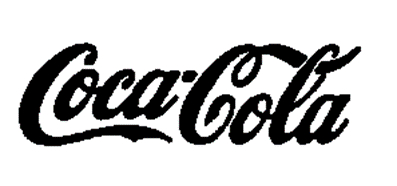
In some cases a design mark may include no words. For example, the swish symbol used to identify Nike products is a registered trademark of Nike.
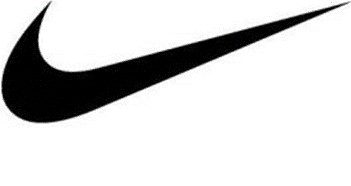
Unlike a word mark, a design mark must always be used exactly as submitted in the application to the USPTO and may not be varied. A design mark may be filed with a claim to specific colors, or in black and white with no claim to specific colors.
